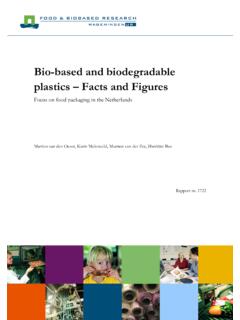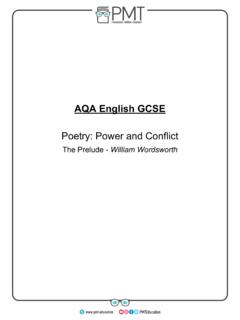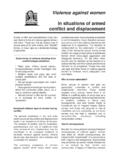Transcription of State and non-state institutions in conflict- affected ...
1 IS AcademyHuman Security in Fragile StatesState and non- State institutions in conflict- affected societiesWho do people turn to for human security ?Gemma van der Haaroccasional paper #6 The IS AcademyThe IS Academy on Human Security in Fragile States is a collaborative research project between the Special Chair Humanitarian Aid and Reconstruction and the Disaster Studies chair at the faculty of social sciences, Wageningen University, the Humanitarian Aid and Stabilisation Department at the Dutch Ministry of Foreign Affairs and five major Dutch NGOs: Cordaid, ICCO, ZOA, Oxfam Novib and the Netherlands Red Cross. The Academy s mission is to better understand processes of socio-economic recovery and the roles of formal and informal institutions in conditions of State fragility. The research comprises several PhD trajectories and a number of short-term research projects, and is geared towards catalyzing cross-fertilizing exchange between the domains of policy, practitioners and academia in the field of socio-economic recovery in fragile IS Academy Human Security in Fragile States publishes articles, occasional papers and research briefs.
2 Occasional papers are essays or reports that are commissioned by the IS Academy to contribute to the debate on a certain topic. The perspective of an occasional paper is the author s and is supported by substantial research. Occasional papers usually come forth from short-term research projects. Other occasional papers, as well as more information on the IS Academy, can be accessed via www. and non- State institutions in conflict- affected societies1 Who do people turn to for human security?Gemma van der Haar20131 This title was inspired by an article by Bruce Baker: Who do people turn to for policing in Sierra Leone? (2005)AcknowledgementsThis text builds on the efforts of many people in different phases of the research. Wim de Regt, Sarah-Jane Koulen, Gemma Andriessen and Fons van Overbeek prepared the foundations. Thea Hilhorst, Peter Tamas and Anne Pieter van Dijk (Oxfam Novib) facilitated the research on the side of the IS Academy Human Security in Fragile States and Oxfam Novib, respectively.
3 Sarah Jane Koulen, Wim de Regt, Anne Pieter van Dijk and Bart Weijs provided important comments to drafts of this report. A final thanks goes to the people who wrote the case reports: Khibar Rassul of CPAU (Afghanistan) and Haroon Ahmed Yusuf of SORADI (Somaliland).All photos courtesy of report was commissioned by OXFAM NOVIB in order to synthesise the OXFAM NOVIB research programme Local institutions : People seeking Human Security , within the framework of the IS ACADEMY Human Security in Fragile by Gemma van der Haar, Wageningen University, opinions expressed are those of the author and do not necessarily reflect the policies or views of Oxfam Novib or the IS the author and researcher via: More information on the IS ACADEMY can be found via of contents Executive summary 51. Introduction 92. Local institutions and human security: research framework 11 Conceptualising non- State institutions in fragile states Human security in fragile states 14 Local institutions and human security: Research approach 153.
4 Research set-up and process 17 Research set-up 17 Somaliland/Puntland study: Sanaag region 18 Afghanistan study: Takhar and Kunduz provinces 194. State and non- State institutions on the ground 21 The importance of customary institutions 21 Home-grown institutions : Tradition and more 22 Other non- State institutions : local civil society, international agencies, the private sector, and armed groups 24 How does the State fit in? 24 Relative legitimacies 255. Local institutions at work : Interaction and change 27 State and non- State institutions responding to crime and violence 27 Multiple institutions responding to drought 29 Changing institutions in water governance 31 Emerging threats to non- State institutions 326. Conclusions 35 Reflections on the research approach 36 Implications for intervention 37 Reference list 393 Executive summaryThe debate on fragile states has triggered an interest in how people organize for everyday security and for issues of common interest in the absence of a functioning State .
5 Drawing on two extensive case studies from Somaliland/Puntland and Afghanistan, this report discusses how people, in contexts of post-conflict State fragility, rely on a range of local institutions and arrangements that are partly home-grown, and partly organized and supported by the central study explores how State and non- State institutions at the local level are put to work to further human security. It asks how, in contexts of State fragility, State and non- State institutions help people cope with and reduce the multiple insecurities in their lives. Starting point for the study has been the insight that fragile states are not ungoverned spaces but instead feature forms of governance and of local ordering that emerge from within: the idea of governance without government as developed by Menkhaus and others ( Menkhaus 2006). Following the literature on hybrid political orders and institutional multiplicity, the scope of non- State governance was defined in a broad way, to include customary forms of authority and social organisation, civil society, humanitarian organisations, rebel organisations or criminal groups, diaspora groups, and the private central question for this study is: How do people interact with local governance institutions ( State /non- State , formal/informal) to shape their human security?
6 In order to understand how local institutions matter to human security in fragile settings, this research traced real responses of real institutions to real problems. The field studies started at people s experienced key threats to their human security and then analysed the responses of different types of institutions to two field studies took place in regions affected by conflict- related State fragility in Somaliland/Puntland (Sanaag region) and Afghanistan (Kunduz and Takhar provinces). These regions have been located, geographically or politically, at the fringes of the State , where the presence of the central State was historically marginal. In these contexts, local societies have typically developed robust and elaborate institutions and arrangements to cater for local needs of order and public goods. The studies discuss what type of institutions are found at the local level in these regions and what role they play in people s search for everyday human security.
7 The focus is on drought and violent inter-tribal conflict (in Sanaag), administration of justice (Takhar), and water distribution (Kunduz). 5 The State has a very limited reachThe studies in Somaliland/Puntland and Afghanistan brought out very clearly that the State had a very limited reach. State presence has been affected by violent conflict and on-going political contestation. Efforts at State building are on-going but, at the time of research, these had as yet done little to increase the presence or legitimacy of the State on the ground . The governance of everyday life in the regions studied relied to an important extent on well-developed and firmly rooted customary and informal institutions . People rely on home-grown institutions to address their everyday human security needsPeople rely on home-grown institutions to address their everyday human security needs related to livelihood stress, resource management and competition, and issues of order, security and conflict resolution.
8 The type of non- State institutions that were found to be relevant primarily included customary authorities, community-level mechanisms for consultation and decision making, and emergent arrangements for addressing specific needs. With this, the findings mostly confirm the existing knowledge on customary institutions in fragile institutions are viewed positively in the eyes of local populationsPeople perceived home-grown institutions as strong, effective and appropriate. However, this was not a given. The legitimacy of these institutions derived from their performance in terms of responding to locally identified needs, familiarity, the fact that they were guided by locally accepted values (including equity), and that there were possibilities for constituencies to steer and hold leadership accountable. When specific institutions no longer meet these expectations, they may enter into decline.
9 People will then look for alternatives, either by seeking to change the existing institution or by turning to an State is both absent and present People mostly experienced the State as missing . Despite efforts at increasing State presence, the State was seen as distant and lacked the legitimacy of home-grown institutions . People had an idea of what a State would ideally provide for them, but experienced a State which in their daily lives, for all practical purposes, could not deliver. The State , however, was clearly present on people s horizons and there were multiple references to the State as an idea, as the bigger whole of which people were part. Non- State institutions were depicted as nested within that bigger polity. In exceptional situations that transcended local response mechanisms, such as the severe drought discussed for Sanaag, State agencies were turned to and did engage with the problem.
10 This was one of the most surprising findings of the study: though people s everyday lives reflected a situation of governance without government , 6they maintained an idea of the State as the ultimate fall-back option in responding to critical events. The institutional landscape in the studied regions is multiple and to some extent hybridBesides the variety of home-grown institutions and the institutions of the State , there were other sets of institutions : armed opposition groups (Afghanistan); and local and international civil society organisations (Somaliland/Puntland). The interaction between customary/home-grown institutions and State institutions could best be described as one of functional complementarity or perhaps pragmatic accommodation. In response to problems such as drought or the control of crime and violence, a concerted strategy was worked out which sought to build on the respective strengths.






